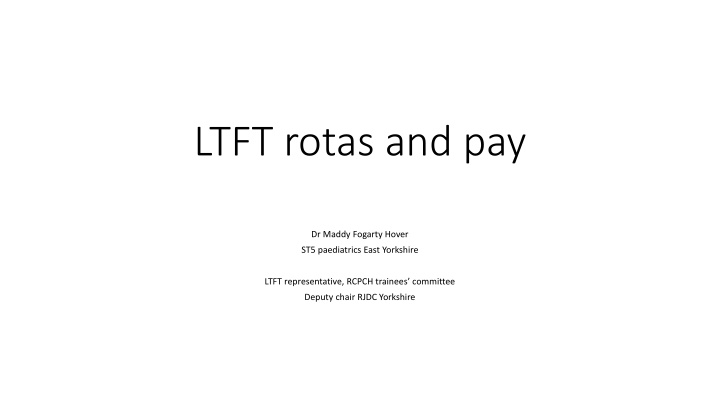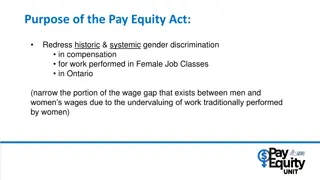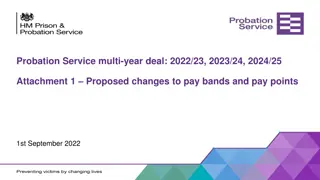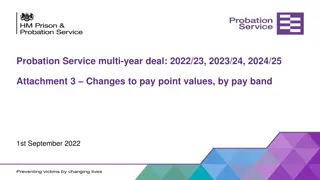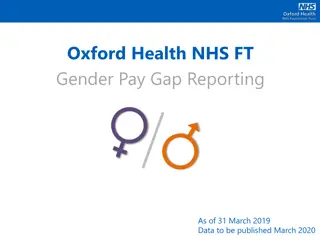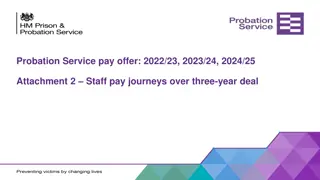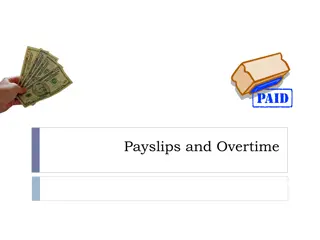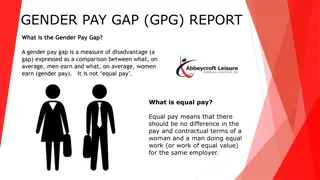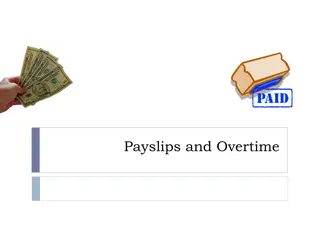LTFT Rotas, Pay, and Work Schedule
In this article, Dr. Maddy Fogarty, a representative for LTFT trainees, provides valuable insights on sorting rotas, understanding work schedules, calculating pay, and ensuring everything aligns smoothly. The content covers various aspects such as rota timeline, ideal rota structure, safety rules to follow, checking rota compliance, and effective strategies to make LTFT work arrangements work best for you.
Download Presentation

Please find below an Image/Link to download the presentation.
The content on the website is provided AS IS for your information and personal use only. It may not be sold, licensed, or shared on other websites without obtaining consent from the author.If you encounter any issues during the download, it is possible that the publisher has removed the file from their server.
You are allowed to download the files provided on this website for personal or commercial use, subject to the condition that they are used lawfully. All files are the property of their respective owners.
The content on the website is provided AS IS for your information and personal use only. It may not be sold, licensed, or shared on other websites without obtaining consent from the author.
E N D
Presentation Transcript
LTFT rotas and pay Dr Maddy Fogarty Hover ST5 paediatrics East Yorkshire LTFT representative, RCPCH trainees committee Deputy chair RJDC Yorkshire
What we will cover How do I sort my rota? What is my work schedule and how does it work? How is my pay calculated? How do I make sure it s all working as it should for me?
Rotas Timeline 12 weeks before rotation: know where you re going 8 weeks before rotating: GENERIC rota & work schedule 6 weeks before rotating: PERSONALISED rota New rotation day!
What should my rota look like? You should do roughly your own percentage of each sort of shift FULL TIME ROTA How many nights? How many long days? How many standard days? How many twilights? How many hours per week on average? I work 60% I should do 60% of nights 60% of long days 60% of standard days 60% of twilights 60% of average hours UNLESS otherwise agreed (for instance, occupational health reasons
Safety rules Max 48 hours/week average Apply to full time and ltft Apply to locum work Max 72 hours in any 7 days (168 hours) Max shift length 13 hours - Min 11h rest between shifts Protect you and patients Max 4 long shifts (>10h) in a row - 48h rest after any 4 long days Exceptions: With agreement can do 5 long days in a row 8 days in a row Up to 1 in 2 weekends Must be agreed & monitored Max 4 nights in a row - 46 h rest after any run of nights Max 7 shifts in a row - 48 hours rest after 7 shifts No more than 1/3 weekends
How do I check its working? ON TIME 8 weeks notice of generic, 6 weeks personalised COMPLIES WITH SAFETY RULES FIXED DAY OFF if at all possible CANNOT BE MADE to work on your day off. But can agree to, if it works for you MIRRORS THE FULL TIME ROTA unless agreed Doing approx. your own percentage of each shift type Hours = YOUR PERCENTAGE of full time And should fall between your percentage of 40 and your percentage of 48 hours
How do I make it work? Contact the department in advance. Discuss expectations, negotiate Ask about teaching days, educational opportunities You need a copy of the full time rota To compare and check Who do I need to contact? Have a handy list! Educational supervisor Clinical supervisor Rota coordinator Medical staffing
Work schedule Sets out both what you will be working AND what you will be doing within the job Rota / hours of work Educational opportunities Mandatory training Your annual, bank holiday and study leave allowance You must get your generic work schedule 8 weeks in advance Personalise it with supervisor If the job doesn t match the work schedule for various reasons, there are mechanisms to solve this problem
Pay Basic nodal point Additional hours Night pay Weekend premium On call premium Flexible pay premia Ltft allowance Also pay protection
Omg its so complicated I promise it s not that bad We will walk through it Go through this every job and make sure you re paid right With a couple of practices it will become super easy
Basic nodal point pay Corresponds to your GRADE Each nodal point is the pay for 40 HOURS As ltft you have to make a calculation Nodal point divided by 40 Multiply by your average weekly hours
Additional hours These are for people working ABOVE 40h/week Each additional hour per week is paid the same as a normal hour As ltft, we don t get any of this Don t worry. Your additional hours are included in your basic pay calculation we did before.
Night pay out of hours pay enhancement Basic hourly pay is increased by 37% for the following hours: Any hours between 9pm and 7am Any hours of a shift starting between 8pm and 11.59 and lasting at least 8h Any hours of a shift starting between midnight and 4am This is averaged monthly over the rota To check it s correct: count up all those hours on your rota Extrapolate how many you would do in one year (so if your rota is calculated over 26 weeks, it s double that) Calculate your hourly rate (nodal point divided by 52 gives you a weekly rate, divide again by 40 for hourly rate so that s nodal point divided by 2080) Multiply this hourly rate by 0.37 this gives you the EXTRA amount each antisocial hour is paid Multiply that last number by the number of antisocial hours per year. This gives you a number that represents HOW MUCH OUT OF HOURS PAY ENHANCEMENT YOU GET PER YEAR. This is the number that appears on your work schedule.
Weekend premium This is based on WEEKEND FREQUENCY LTFT is based on YOUR ACTUAL FREQUENCY COMPARED TO FULL TIME FREQUENCY Note this is not the same as your training percentage Example: If the fulltimers work 1 in 3 weekends, and you work 1/6, you work 50% of their frequency, you get 50% of their FULLTIME weekend enhancement If they work 1/3 weekends but you work , you do 75% of their frequency, you get 75% of their fulltime enhancement If they work 1/3 weekends and you do too, you do 100% of their frequency, you get 100% of their fulltime enhancement
On call premium This is for people working NON RESIDENT ON CALL Two parts: ON CALL AVAILABILITY ALLOWANCE: 8% of full time basic pay PAYMENT FOR WORK UNDERTAKEN ON CALL: An amount is estimated in advance If more is worked, this will be paid For LTFT Availability allowance: you get the percentage of the fulltime amount that represents your contribution to the rota (do half the on calls, get half the amount) Work undertaken: you get what you do
Flexible pay premia There are various pay premia Hard to fill specialties General practice Clinical academic OMFS As LTFT you get your PRO RATA (percentage) amount per year
LTFT allowance 1000 per year for all LTFT trainees paid under the 2016 payscales
Pay protection Various arrangements to cover doctors Who were employed before the new contract came in Who switch into a hard to fill specialty Who switch specialties due to disability or caring Who reenter training from a non-training grade Who move between the different nations
How do I make it all work? You will need Your ROTA Your WORK SCHEDULE Your PAYSLIP when you have it The FULL TIME ROTA Check the basic info is right Check the work schedule matches the rota for ALL shifts Calculate your weekend frequency compared to full time Check your weekend enhancement is correct Check your enhanced hours are correct Check you re being paid any additional pay premia / ltft allowance
Common pitfalls & troubleshooting Work schedule doesn t match rota Check both carefully by hand Average hours calculated over too many weeks This incorrectly drops your average hours 1st and last half week should be amalgamated into one Incorrect basic nodal point Check on work schedule and payslip This is a quite complex problem Weekend frequency calculated incorrectly It s not your training percentage. It s the percentage of the fulltime weekend frequency that you do You need a full time rota to check this Sadly it commonly goes wrong LTFT allowance left off Find it on work schedule and payslip Beware! Riddell formula applied incorrectly Look at the TOTAL HOURS AFTER ADJUSTMENT FOR LEAVE This should ALWAYS, ALWAYS, ALWAYS be higher than the total hours before leave adjustment If it s lower, there is a PROBLEM and you will be UNDERPAID
What if there is a problem? Do your checks Initiate a dialogue Supervisor, rota coordinator, medical staffing, payroll... Escalate as necessary Guardian of safe working, flexible working champion, junior doctors forum, union
Now I need a day off You re entitled to PRO RATA annual leave and bank holidays Annual leave for full timers: Who have worked less than 5yrs in NHS: 27 days Who have worked 5 or more years in NHS: 32 days Plus 8 bank holidays per year Yours is calculated together as one big pot of leave Annual and bank holidays together Then you use days of this leave to book bank holidays off You use one day of this leave if you re on a standard day and get BH off You don t use a day if you work a BH, or if it falls on a ZERO or a NON WORKING DAY Example: 60%, worked 2yrs in NHS (27+8)x0.6 = 21 days per year total leave
I cant remember any of THAT That s fine Here is where you find all the information you need Your TERMS AND CONDITIONS OF SERVICE https://www.nhsemployers.org/-/media/Employers/Documents/Pay-and-reward/Junior- Doctors/NHS_Doctors_and_Dentists_in_training_England_TCS_2016_VERSION-9.pdf Very important, read through it, it has all your pay information. All the salary scales are here, in the pay circular, frequently updated: https://www.nhsemployers.org/-/media/Employers/Documents/Pay-and- reward/Pay-and-Conditions-Circular-MD-12021.pdf (all tables from here) Joint Rostering Guidance https://www.nhsemployers.org/-/media/Employers/Publications/NHSE-BMA-Good-rostering-170518-final.pdf Guide, not contractual Agreed between BMA and NHSE: how to make a good rota. Has an LTFT bit The BMA has info too https://www.bma.org.uk/pay-and-contracts/contracts/junior-doctor-contract/junior-doctor-contract-in-england Give us an email if you re stuck! Maddyfogartyhover@gmail.com I am happy to discuss this stuff!
